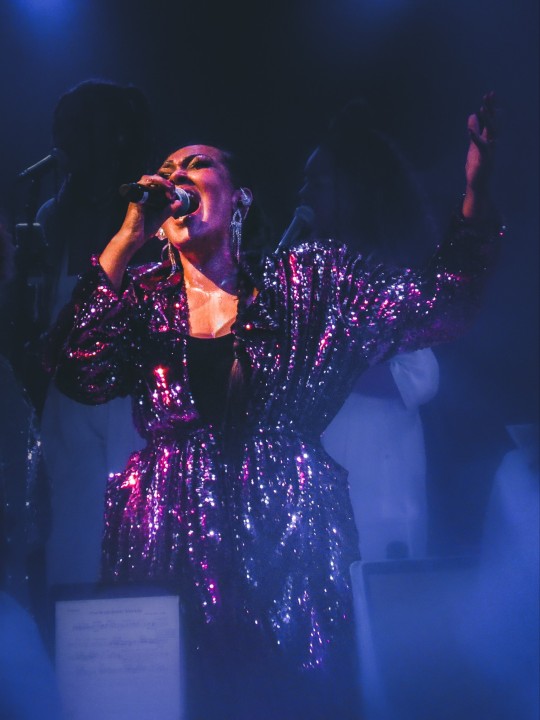#ccsp
Explore tagged Tumblr posts
Text




Show do Pullovers no CCSP
CCSP, São Paulo - Brasil
01/02/2025
vida vale a pena?
#Pullovers#vida vale a pena#tudo que eu sempre sonhei#CCSP#são paulo#sp#camera digital#cybershot#digital camera#digicam#fotografia#banda pullovers
3 notes
·
View notes
Text






📷 Montagem da exposição "Espaços do Ainda" em curso, pessoal. Abertura está chegando. É no sábado, dia 1. de julho, às 11 horas no CCSP. E tem visita com o curador Luiz Cláudio da Costa às 12h, não se esqueça. Nos vemos lá!
1. Patricia Franca-Huchet 2. Livia Flores. Eles riram. 2019-2022. Guache preto sobre folhas de jornal série de 80 desenhos 3. Christus Nóbrega. Gráfica Paraíba, Arte em Panfleto. 2021-2022. Instalação composta por cartazes, panfletagem, bandeiras e livros dimensões variadas 4. Detalhe da obra do artrista Christus Nóbrega. 5. Ana Emerich. 6. Vista da montagem da exposição do piso Flávio de Carvalho do Centro Cultural São Paulo - CCSP. Esse lugar é lindo, não é?
Abertura: 1. de julho de 2023, sábado, às 11h; e visita guiada às 12h Período expositivo: de 2 de julho a 13 de agosto de 2023 Horários: terça a sexta, das 10h às 20h; sábado, domingo e feriados, das 10h às 18h Local: Centro Cultural São Paulo - CCSP Endereço: Rua Vergueiro, 1000, Paraíso, São Paulo - SP Não é necessária retirada de ingresso
🔗 Press-release + 📷: https://encr.pw/tt0Pr
#espacosdoainda #centroculturalsaopaulo #centroculturalsp @centroculturalsp #ccsp #artecontemporanea #arte #precariedade #proac #agenda #anotenaagenda
Instagram dos artistas participantes:
@patriciafrancahuchet @anaemerich @leiladanziger @christusnobrega @rosanapaulino.oficial @livia__flores @florianoromano @miranda.mirando.cris
Curadoria: @luiz.claudio.da.costa Produção: @fridaprojetos Comunicação: @deciogiorgi
#arte contemporânea#são paulo#ccsp#centro cultural são paulo#espaços do ainda imagens#ana emerich#christus nóbrega#leila danziger#luiz cláudio da costa#rosana paulino
2 notes
·
View notes
Text

Visit Certified Chiropractic Sports Physician
Visiting a certified chiropractic Sports Physician ensures you're getting specialized attention backed by extensive training in sports medicine and chiropractic care. Dr. Haworth is the only chiropractor in the Tahoe area that has a Master’s degree in Exercise and Sports Science and Certified Chiropractic Sports Practitioner®. We make it a top priority to help our patients reach their health and lifestyle goals.
#CertifiedChiropracticSportsPhysicia#CCSP#SportsChiropractic#ChiropracticCare#SportsMedicine#InjuryPrevention
0 notes
Text
10º CopaVela YCP 2025
CopaVela YCP 2025Nos dias 1 e 2 de março foi disputada a CopaVela YCP 2025 em ótimas condições de tempo e vento, com a Represa de Guarapiranga com seu nível plenamente recuperado em relação à estiagem que marcou o segundo semestre do ano passado. Com um total de 41 inscritos nas classes Snipe, Star, HPE25, Finn, ILCA 4 e ILCA 6, cinco regatas puderam ser realizadas com ventos oscilando entre 9 e…

View On WordPress
#CCSP#classe snipe de são paulo#guarapiranga#Regata#represa#são paulo#snipe#snipe divas#snipeclass#snipesaopaulo#SPYC#vela#YCP#YCSA
0 notes
Text
youtube
0 notes
Text
Top 10 CCSP Interview Questions and Answers in 2025

The Certified Cloud Security Professional (CCSP) certification is among the most sought-after certifications for professionals working in the security of cloud services. With the constantly evolving cloud technology and the increasing emphasis on the security of sensitive information, businesses are always looking for professionals with the right skills. If you're in the process of preparing for an CCSP exam in 2025, then you're at the right spot. This is a simple but insightful guide that covers the most frequently asked CCSP Interview questions as well as responses to help you pass your interview.
1. What is the CCSP certification, and why is it important?
It is a typical question interviewers will ask you to test your knowledge of the certificate.
Answer: The CCSP certification offered by (ISC)2 is proof of a professional's understanding of cloud security architecture design, operation, and orchestration of services. It's extremely valuable since it shows your proficiency in securing cloud environments, which is essential for companies who are implementing cloud solutions.
2. Explain the six domains of the CCSP Common Body of Knowledge (CBK).
This test will assess your basic understanding. Answer: Six domains in CCSP CBK are:
Cloud Concepts Architecture, Cloud Concepts and Design It covers the most fundamental concepts of cloud computing.
Cloud Data Security: Focuses on the protection of data throughout its lifespan.
Cloud Platform and Infrastructure Security Cloud Platform and Infrastructure Security: Covers security concerns of cloud platforms.
Secure Cloud Applications: Provides safe cloud-based applications.
Cloud Security Operations Discussion of the operational controls.
Legal, Risk and Compliance includes regulatory requirements as well as risk-management.
3. What are the shared responsibilities in a cloud environment?
This test is designed to assist you in testing your knowledge of cloud providers and roles for users.
Answer: In a cloud-based environment sharing responsibility divides security responsibilities among Cloud service providers (CSP) as well as the user. For instance:
CSP responsibility Security in the cloud (hardware software, hardware, physical and network infrastructures).
Security for the customer: Customer responsibilities within the cloud (data security, access management as well as compliance).
4. What is multi-tenancy, and how does it impact security?
Multi-tenancy is a hot subject within cloud computing.
Answer: Multi-tenancy lets multiple users utilize all of the cloud's resources. While it's cost effective it can also create security issues like data isolation, unauthorised access and compliance concerns. Implementing effective encryption and access controls can reduce the risk.
5. Can you explain cloud data lifecycle management?
Interviewers might want to assess your skills in dealing with cloud-based data.
Answer: The lifecycle of cloud data consists of the following phases:
Create by generating or collecting data.
Storage: Securely saving data.
Utilization Processing and accessing data.
Share: Sharing data using the right controls.
Archive: Storage of long-term data.
Destroy: Safely deleting information when it is no longer needed.
6. What is the difference between public, private, and hybrid clouds?
This is a crucial aspect to be able to comprehend various cloud environments.
Answer:
Public cloud: Shared infrastructure accessible to the general public (e.g., AWS, Azure).
Private cloud: A dedicated cloud of resources for a single company.
Hybrid cloud: Combination of private and public cloud services to provide greater agility and safety.
7. How do you handle data breaches in the cloud?
This test will test your problem-solving abilities.
Answer: In the event of a breach:
Find the breach and isolate it.
Notify relevant authorities and the stakeholders.
Examine the root of the issue.
Reduce the problem (e.g. patches for vulnerability).
Improve security measures in the future and review policies.
8. What are some key cloud compliance standards?
The importance of compliance is paramount in cloud security.
Answer: A few important compliance standards are:
ISO/IEC 27017 Security of Clouds ISO/IEC 27017 guidelines.
GDPR: Secures personal data of users within the EU.
HIPAA: Ensures health data security.
PCI DSS: For secure payments.
9. How do encryption and key management work in the cloud?
It is a crucial element in cloud security.
Answer: The encryption process secures data by changing it into a format that is coded. Key management involves the creation keys, storing, dispersing encryption keys, and revoking the encryption keys. A well-organized key management system makes sure that authorized individuals have access to gain access to encrypted information.
10. What is CASB, and why is it important?
This advanced question tests your experience with certain security tools.
Answer: The Cloud Access Security Broker (CASB) is security checkpoints between the cloud provider and its users. It is a feature-rich platform that provides protection against data loss (DLP) and security against threats, and access to cloud activities.
Conclusion
The preparation for a CCSP test in 2025 demands a strong understanding of cloud security fundamentals, practical experience, and knowledge gained from Cyber Security Certification Courses. By gaining a solid understanding of the Top 10 CCSP interview questions and responses, you'll be on your way to impress prospective employers. The crucial element to succeeding in your interview lies in showing the capability to use your skills to real-life situations.
FAQs
Q1. How much time will it take to get ready for taking the CCSP certification?
The preparation for the CCSP generally takes between 3-6 months, based on your previous experience with cloud security.
Q2. Is CCSP certification worthwhile in 2025?
With organizations increasingly using cloud-based options, CCSP remains one of the most prestigious certifications to validate cloud security knowledge.
Q3. What are the necessary requirements for the CCSP exam?
You must have at least 5 years of working experience in IT with 3 years in security of information and 1 year of cloud security.
Q4. What is the pass result for the CCSP exam?
The CCSP test has the CCSP exam with 125 multiple-choice questions, and you must score at least 700 points out of 1000 in order to pass.
0 notes
Text

1 note
·
View note
Text
Why the CCSP Certification Should be Priority in Cloud Security Career
Cloud security has become an ever-more essential aspect of modern life. As more businesses move their data-sensitive processes and regulatory compliance initiatives to the cloud, demand has surged for professionals who can secure these environments. Companies prioritize data protection initiatives as regulatory compliance initiatives increase in importance - one way they could advance in their careers by earning their Certified Cloud Security Professional (CCSP) certificate.

Why is Certified Cloud Security Professional certification one of the premier certifications for cloud security professionals? Let's examine why it should form part of your career plans in our increasingly cloud-centric world.
1. An Increased Demand for Cloud Security Professionals
The global move to cloud computing has been dramatic and continues to gain speed; Gartner estimates that by 2025 nearly 85% of organizations will have adopted it compared with only 35% today. Businesses taking advantage of its flexibility, scalability, cost-efficiency as well as increased security risks such as data breaches, misconfigurations and cyberattacks now more than ever depend on cloud security professionals due to these increased threats - further emphasizing their relevance than before.
Certified Cloud Security Professional (CCSP). This certification equips professionals with the skills and knowledge required to effectively secure cloud environments - making them indispensable to organizations. As such, professionals who hold this credential are in high demand on the job market; regardless of previous experience with cloud security or being newcomers themselves; earning your CCSP credential shows your unique expertise protecting an organization's most valued assets on cloud environments.
2. Gain A Broad Skill Set In Cloud Security
The Certified Cloud Security Professional exam (CCSP) covers an impressively comprehensive set of subjects, making it one of the most in-depth certifications available. By passing it, you'll gain expertise across few domains of cloud security:
Concepts, Architecture and Designs for Cloud Data Security
Platform and Infrastructure Security
Application Security Operations
Legal, Risk, and Compliance
Each of these three domains provides essential cloud security solutions - from encryption and access management to meeting global regulations such as GDPR. CCSP certification is proof of your competence for effective cloud security - making you an indispensable addition to any organization.
Becoming a Certified Cloud Security Professional (CCSP) means becoming skilled with all the tools of cloud security - from lockpicking and reinforcing walls, to understanding digital landscape laws, as well as recognizing vulnerabilities before they become issues - giving employers peace of mind that their cloud environment will remain protected against security challenges of all sorts.
3. Industry Recognition and Credibility
The Certified Cloud Security Professional certification from (ISC)2 is widely respected among cybersecurity certification circles, and employers worldwide regard it as one of the premier cloud security credentials. By including this on your resume, instant credibility with hiring managers and decision makers arises instantaneously.
Imagine receiving recognition from an authoritative figure in cybersecurity for meeting rigorous standards and possessing the expertise required to secure cloud infrastructures. Recognition could open doors to new job opportunities, career advancement prospects and salary hikes - so don't take that recognition lightly - it could change everything!
As this certification is vendor-neutral, your skills can be utilized on all cloud platforms from AWS and Azure to Google Cloud; making you flexible in an ever-evolving industry.
4. Staying Up-to-Date With Industry Developments
The cloud industry is constantly changing and adapting, with new technologies, practices and threats emerging regularly - it can be hard to keep up with them all without certification such as CCSP; but doing so offers invaluable advantages: you will not only learn best practices and current frameworks; you will also keep abreast of trends and challenges within this space.
By becoming a Certified Cloud Security Professional (CCSP), you demonstrate your dedication to ongoing learning and adaptation within an ever-evolving cloud environment. As cloud security evolves, professionals with this credential are well prepared to quickly address new challenges such as multi-cloud environments, compliance regulations or counteracting cyber threats quickly and efficiently.
5. Launchpad to Career Advancement
The CCSP certification provides an effective path towards career advancement whether you are just entering cloud security, or looking to advance within IT and cybersecurity roles. By specializing within cloud security - leading to positions such as Cloud Security Architect/Engineer; even Chief Information Security Officer (CISO).
Students and early-career professionals looking to establish themselves as experts in cloud security could gain an edge when applying for roles related to cloud security by becoming Certified Cloud Security Professional (CCSP).
6. Increase Your Earning Potential
Certifications play an essential part of cybersecurity careers, helping determine earning potential and the Global Knowledge IT Skills and Salary Report consistently ranks CCSP certification among the highest-paying ones available to professionals worldwide - particularly at organizations who prioritize cloud security as a priority and thus can command higher salaries for its certified members than non-certified peers.
Acquiring the Certified Cloud Security Professional certification can bring both professional and financial benefits.
Conclusion
As cloud services become an integral component of daily life, skilled cloud security professionals have never been in higher demand. Acquiring Certified Cloud Security Professional status can serve as an invaluable asset in this fast-evolved sector; providing extensive knowledge, industry recognition and the credentials essential to long-term success.
Earning the Certified Cloud Security Professional certification is an investment in yourself, equipping yourself with the knowledge to face the unique challenges associated with cloud environments. No matter where your career may lead you, gaining this credential could provide an important path toward becoming an authority on this rapidly expanding area of cloud security.
As cloud computing rapidly evolves, becoming a Certified Cloud Security Professional (CCSP) represents more than an investment in certification; it represents an opportunity to further your career.
0 notes
Text
Surpopulation carcérale: près de 200 détenus dorment à même le sol dans les prisons belges | RTL Info
Source: RTLINFO
0 notes
Text
COPYLEFT at CCSP - Centro Cultural de São Paulo
7 solos of 7 minutes.
1 note
·
View note
Text
Protecting your brand in the age of AI - CyberTalk
New Post has been published on https://thedigitalinsider.com/protecting-your-brand-in-the-age-of-ai-cybertalk/
Protecting your brand in the age of AI - CyberTalk


Mark Dargin is an experienced security and network architect/leader. He is a Senior Strategic Security Advisor, advising Fortune 500 organizations for Optiv, the largest pure-play security risk advisory organization in North America. He is also an Information Security & Assurance instructor at Schoolcraft College in Michigan. Mark holds an MS degree in Business Information Technology from Walsh College and has had dozens of articles published in the computing press. He holds various active certifications, including the CRISC, CISSP, CCSP, PMP, GIAC GMON, GIAC, GNFA, Certified Blockchain Expert, and many other vendor related certifications.
In this timely and relevant interview, Senior Strategic Security Advisor for Optiv, Mark Dargin, shares insights into why organizations must elevate brand protection strategies, how to leverage AI for brand protection and how to protect a brand from AI-based threats. It’s all here!
1. For our audience members who are unfamiliar, perhaps share a bit about why this topic is of increasing relevance, please?
The internet is now the primary platform used for commerce. This makes it much easier for brand impersonators, and counterfeiters to achieve their goals. As a result, security and brand protection are essential. According to the U.S. Chamber of Commerce, counterfeiting of products costs the global economy over 500 billion each year.
Use of emerging technologies, such as artificial intelligence (AI) and deepfake videos — which are used to create brand impersonations — has increased significantly. This AI software can imitate exact designs and brand styles. Deepfake videos are also occasionally used to imitate a brand’s spokesperson and can lead to fraudulent endorsements.
Large language models (LLMs), such as ChatGPT, can also be used to automate phishing attacks that spoof well-known brands. I expect for phishing attacks that spoof brand names to increase significantly in sophistication and quantity over the next several years. It is essential to stay ahead of technological advancements for brand protection purposes.
2. How can artificial intelligence elevate brand protection/product security? What specific challenges does AI address that other technologies struggle with?
Performing manual investigations for brand protection can require a lot of time and resources to manage effectively. It can significantly increase the cost for an organization.
AI is revolutionizing brand protection by analyzing vast quantities of data, and identifying threats like online scams and counterfeit products. This allows brands to shift from reacting to threats to proactively safeguarding their reputation.
AI can increase the speed of identifying brand spoofing attacks and counterfeiting. Also, it can dramatically shorten the time from detection to enforcement by intelligently automating the review process and automatically offering a law enforcement recommendation.
For example, if a business can identify an online counterfeiter one month after the counterfeiter started selling counterfeit goods vs. six months later, then that can have a significant, positive impact on an organization’s revenue.
3. In your experience, what are the most common misconceptions or concerns that clients express regarding the integration of AI into brand protection strategies? How do you address these concerns?
If used correctly, AI can be very beneficial for organizations in running brand protection programs. AI technologies can help to track IP assets and identify infringers or copyright issues. It is important to note that AI is an excellent complement to, but cannot fully replace, human advisors.
There are concerns amongst security and brand protection leaders that AI will cause their investigative teams to rely solely on AI solutions vs. using human intuition. While tools are important, humans must also spend an adequate amount of time outside of the tools to identify bad actors, because AI tools are not going to catch everything. Also, staff must take the time to ensure that the information sent to the tool is correct and within the scope of what is required. The same goes for the configuration of settings. At a minimum, a quarterly review should be completed for any tools or solutions that are deployed.
Leaders must ensure that employees do not solely rely on AI-based tools and continue to use human intuition when analyzing data or identifying suspicious patterns or behaviors. Consistent reminders and training of employees can help aid in this ongoing process.
Training in identifying and reporting malicious use of the brand name and counterfeiting should be included for all employees. It is not just the security team that is responsible for protecting the brand; all employees should be part of this ongoing plan.
4. Can AI-based brand protection account for regional, local or otherwise business-specific nuances related to brand protection and product security? Ex. What if an organization offers slightly different products in different consumer markets?
Yes, AI brand protection solutions can account for these nuances. Many organizations in the same industry are working together to develop AI-based solutions to better protect their products. For example, Swift has announced two AI-based experiments, in collaboration with various member banks, to explore how AI could assist in combating cross-border payments fraud and save the industry billions in fraud-related costs.
We will continue to see organizations collaborate to develop industry-specific AI strategies for brand protection based on the different products and services offered. This is beneficial because attackers will, at times, target specific industries with similar tactics. Organizations need to account for this. Collaboration will help with protection measures, even in simply deciding on which protection measures to invest in most heavily.
5. Reflecting on your interactions with clients who are exploring AI solutions for brand protection, what are the key factors that influence their decision-making process? (ex. Budget, organizational culture, perceived ROI).
From my experience, the key factor that influences decision-making is the perceived return on investments (ROI). Once the benefits and ROI are explained to leaders, then it is less difficult to obtain a budget for investing in an AI brand protection solution. Many organizations are concerned about their brand name being used inappropriately on the dark web and this can hurt an organization’s reputation. Also, I have found that AI security solutions that can help aid an organization in achieving compliance with PCI, GDPR, HITRUST, etc., are more likely to receive approval and support from the board.
Building a culture of trust should not begin when change is being implemented; but rather in a much earlier phase of planning or deciding on which changes need to be made. If an organization has a culture that is not innovative, or leaders who do not train employees properly on using AI security tools or who are not transparent about the risks of it, then any investment in AI will face increased challenges.
AI’s high level of refinement means it can reduce the time and increase the scope of responsibility for individuals and teams performing investigations, enabling them to focus on other meaningful tasks. Investigations that were once mundane become more interesting due to the increased number of unique findings that AI is able to provide.
Due to the time saved by using AI in identifying attacks, investigators will have more time to pursue legal implications; ensuring that threat actors or brand impersonators are given legal warnings or charged with a crime. This can potentially discourage the recurrence of an attack from the specific source that receives the warning.
6. Could you share insights from your experience integrating AI technologies designed for brand protection into comprehensive cyber security frameworks? Lessons learned or recommendations for CISOs?
Security and brand protection leaders are seeing criminals use artificial intelligence to attack or impersonate brand names and they can stay ahead of those threats by operationalizing the NIST AI Risk Management Framework (AI RMF), and by mapping, measuring, and managing AI security risks. The fight moving forward in the future is AI vs AI. It is just as important to document and manage the risks of implementing AI as is to document the risk of attackers using AI to attack your brand name or products.
Leaders need to start preparing their workforce to see AI tools as an augmentation rather than substitution. Whether people realize it or not, AI is already a part of our daily lives, from social media, to smartphones, to spell check, to Google searches.
At this time, a task that was a challenge before can be done a lot faster and more efficiently with the help of AI. I am seeing more leaders who are motivated to educating security teams on the potential uses of AI for protecting the brand and in preventing brand-based spoofing attacks. I see this in the increased investments in AI-capable security solutions that they are making.
7. Would you like to speak to Optiv’s partnership with Check Point in relation to using AI-based technologies for brand protection/product security? The value there?
Attackers target brands from reputable companies because they are confident that these companies have a solid reputation for trustworthiness. Cyber criminals also know that it is difficult for companies, even large companies, to stop such brand impersonations by themselves, if they do not have appropriate tools to aid them.
Optiv and Check Point have had a strong partnership over many years. Check Point has a comprehensive set of AI solutions that I had the luxury of testing at the CPX event this year. Check Point offers a Zero-Phishing AI engine that can block potential brand spoofing attempts, which impersonate local and global brands across multiple languages and countries. It uses machine learning, natural language processing, and image processing to detect brand spoofing attempts. This provides security administrators with more time to focus on other security-related tasks or can alert them when something suspicious occurs within the environment.
The value in using AI solutions from vendors such as Check Point is the reduction in time spent detecting attacks and preventing attacks. In effect, this can empower organizations to focus on the business of increasing sales.
8. Can you share examples of KPIs/metrics that executives should track to measure the effectiveness of AI-powered brand protection initiatives and demonstrate ROI to stakeholders?
Generative AI projects concerning brand protection should be adaptable to specific threats that organizations may have within their environments at specific times. KPIs related to adaptability and customization might include the ease of fine-tuning models, or the adaptability of protection safeguards based on a specific input. The more customizable the generative AI project is, the better it can align with your specific protection needs, based on the assessed threats.
Organizations need to measure KPIs for the AI brand protection solutions that they have deployed. They should track how many attacks are prevented, how many are detected, and how many are successful. These reports should be reviewed on a monthly basis, at the least, and trends should be identified. For example, if successful attacks are increasing over a span of three months, that would be a concern. Or if you see the number of attacks attempted decreasing, that could also be something to look into. In such cases, consider investigating, as to ensure that your tools are still working correctly and not missing other attempted attacks.
9. In looking ahead, what emerging AI-driven technologies or advancements do you anticipate will reshape the landscape of brand protection and product security in the near future? How should organizations prepare? What recommendations are you giving to your clients?
Attackers will be increasing their use of AI to generate large-scale attacks. Organizations need to be prepared for these attacks by having the right policies, procedures, and tools in place to prevent or reduce the impact. Organizations should continually analyze the risk they face from AI brand impersonation attacks using NIST or other risk-based frameworks.
Security and brand leaders should perform a risk assessment before recommending specific tools or solutions to business units, because this will ensure you have the support needed for a successful deployment. It also increases the chance for approval of any unexpected expenses related to it.
I expect that there will be an increase in the collaboration between brands and AI-capable eCommerce platforms to jointly combat unauthorized selling and sharing of data and insights, leading to more effective enforcement. When it comes to brand protection, this will set the stage for more proactive and preventative approaches in the future, and I encourage more businesses to collaborate on these joint projects.
Blockchain technologies can complement AI in protecting brands, with their ability to provide security and transparent authentication. I expect that blockchain will be utilized more in the future in helping brands and consumers verify the legitimacy of a product.
10. Is there anything else that you would like to share with our executive-level audience?
As the issue of brand protection gains prominence, I expect that there will be regulatory changes and the establishment of global standards aimed at protecting brands and consumers from unauthorized reselling activities. Organizations need to stay on top of these changes, especially as the number of brand attacks and impersonations is expected to increase in the future. AI and the data behind it are going to continue to be important factors in protecting brand names and protecting businesses from brand-based spoofing attacks.
It is essential to embrace innovation and collaboration in brand protection and to ensure that authenticity and integrity prevail, given the various threats that organizations face. Let’s be clear that one solution will not solve all problems related to brand protection. Rather, the use of various technologies, along with human intuition, strong leadership, solid processes, and collaboratively created procedures are the keys to increased protection.
#ai#ai security#AI security tools#ai tools#AI-powered#America#amp#Articles#artificial#Artificial Intelligence#assessment#assets#attackers#authentication#billion#Blockchain#board#brand image#brand protection#brand spoofing#brands#Building#Business#CCSP#Certifications#challenge#change#chatGPT#Check Point#CISOs
0 notes
Text
Fat Family @ Centro Cultural São Paulo 28/02/2024










#point and shoot#concert#livemusic#live music#saopaulo#são paulo#pointandshoot#musica#brazilian music#ccsp#tim maia#fat family#canon g15#canon powershot#prism filter#musica brasileira#música brasileira
1 note
·
View note
Video
Todos no mesmo passo por João Otavio Dobre Ferreira
#FlicrkrFriday#Harmony#Harmonia#Armonia#Dança#Dance#passo#Passinho#CentroCultural#CCSP#CentroCulturalSãoPaulo#Paraíso#Aclimação#Liberdade#SãoPaulo#SP#UrbanLife#UrbanStyle#UrbanArt#UrbanDance#VidaUrbana#ArteUrbana#Urbex#FotografiaUrbana#UrbanShot#FotoUrbana#Photography#Photo#Fotografia#Foto
0 notes
Text
In cloud security, the chain of custody refers to the sequential record-keeping or documentation that tracks the handling, transfer, access, and storage of digital evidence. This process ensures the integrity, authenticity, and reliability of the evidence, especially when utilized for forensic investigations or legal proceedings.
0 notes
Text
What are the job roles available after CCSP?
The CCSP certification validates the knowledge and skills necessary to design, implement, and manage cloud security solutions. It covers a wide range of topics, including cloud architecture and design, data security, platform and infrastructure security, application security, security operations, and legal, risk, and compliance.
0 notes
Text





🤝Hand holding support is available with 100% passing assurance🎯 📣Please let me know if you or any of your contacts need any certificate📣 📝or training to get better job opportunities or promotion in current job📝 📲𝗖𝗼��𝘁𝗮𝗰𝘁 𝗨𝘀 : Interested people can whatsapp me directly ✅WhatsApp :- WhatsApp https://wa.link/tq2u7b 💯Proxy available with 100% passing guarantee.📌 🎀 FIRST PASS AND THAN PAY 🎀 ISC2 : CISSP & CCSP Cisco- CCNA, CCNP, Specialty ITILv4 CompTIA - All exams Google-Google Cloud Associate & Google Cloud Professional People Cert- ITILv4 PMI-PMP, PMI-ACP, PMI-PBA, PMI-CAPM, PMI-RMP, etc. EC Counsil-CEH,CHFI AWS- Associate, Professional, Specialty Juniper- Associate, Professional, Specialty Oracle - All exams Microsoft - All exams SAFe- All exams Scrum- All Exams Azure & many more… 📲𝗖𝗼𝗻𝘁𝗮𝗰𝘁 𝗨𝘀 : If you interested in any of the IT #Certification #Trainig & #Dumps Please Ping me for further details WhatsApp https://wa.link/tq2u7b
0 notes